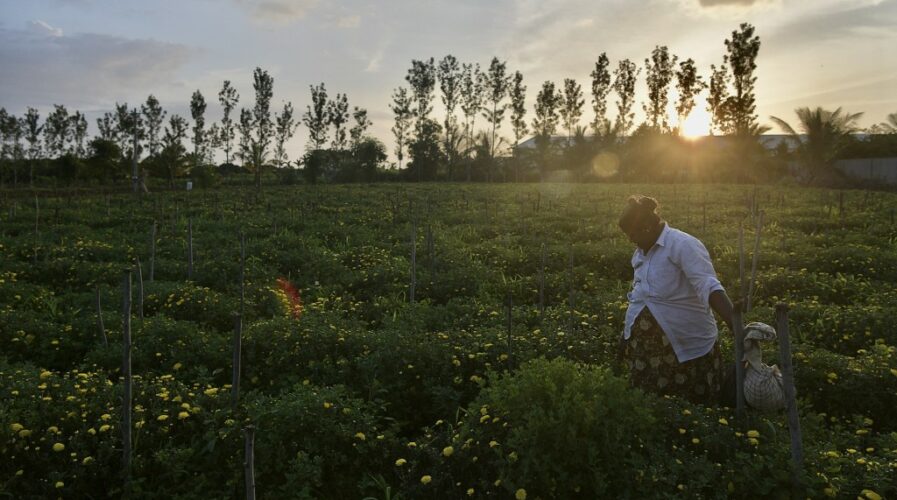
AI applications across the supply chain in the traditionally manual agriculture sector may pave the way for a better life for farmers. (Photo by Manjunath Kiran / AFP)
The applications of AI in India’s agriculture industry
AI applications and agritech may just be the answer to India’s stagnating agriculture industry. With a population of 1.27 billion, India is the world’s second-most populous country and the world’s seventh-largest at 3.288 million sq km.
India produces 25% of the world’s pulses and is also the second-largest producer of rice, wheat, sugarcane, cotton, groundnuts, as well as fruits and vegetables.
Agriculture a large industry, but with negative growth
According to the Food and Agriculture Organization of the United Nations (FAO), agriculture also happens to be the largest source of livelihood for Indians — 70% of rural households still depend on agriculture for their livelihoods.
Despite this, the industry’s contribution to its GDP has declined from 1951 to 2011. A whopping 82% of farmers are still small and marginal in impact.
Although the nation has achieved grain self-sufficiency, production remains resource-intensive, cereal-centric, and regionally biased. Food security is still an issue for the majority of people, and the poverty rate is still high at 30%.
Furthermore, women more than men are negatively impacted as women are not only contributing labor on the field but are expected to handle domestic responsibilities as well.
AI applications in India’s agriculture sector
Enter agritech startups, who are approaching these issues with innovation and the use of technology such as artificial intelligence (AI). AI application in their solutions provides a range of improvisation options — from farmland labor to fintech, to data analytics, amongst others.
Although the role of these agritech startups is still small in the grander scheme of things, the Indian agritech market is still very promising. According to an analysis by Inc42, by 2025, the market is expected to reach US$ 24 billion, although currently, only one percent (US$ 204 million) has been tapped.
Aggromalin enables farmers to diversify their production into animal husbandry and aquaculture with its platform. It helps farmers to increase incomes from farming through the organization of input of supply as well as marketing outputs. Their AI application of deep learning will power IoT monitoring in the future for these farmers as well.
Hyderabad-based Nebulaa, on the other hand, uses AI to optimize quality testing of agricultural produce. Their proprietary solution, MATT, uses AI and image processing to conduct rapid quality analysis of grains, cereals, and pulses in just a minute.
Traditionally, testing for produce is a manual process carried out by chemists and takes anywhere between 30 – 45 minutes per test. The AI applications of MATT massively reduces human error and subjectivity, thus optimizing the supply chain process so farmers can test more and ensure better production quality.
AI is also leveraged by multiple other startups working on post-harvest quality. One of them is Intello Labs’ Tartansese that guides field robots.
Eruvaka’s IoT (Internet of Things) with AI applications is also used in aquaculture, and Fasal’s system uses predictive algorithms for their smart farming solutions.
Recently, Mumbai-based startup investment platform We Founder Circle (WFC) helped raise deals amounting to US$ 2.5 million for three agritech startups.
They include Anveshan, an organic food startup with traceability tech; Humus, a farm to kitchen retail brand; and Hesa, a rural distribution startup that uses a hybrid physical and digital (phygital) model and last-mile connectivity to villages to buy and sell.
What next for India’s agriculture industry?
Currently, agriculture in India is resource-intensive — sustainability is an issue due to high water use, desertification, and land degradation.
All of these pose an even greater threat to the agricultural industry at large. Additionally, farmers suffer from low landholding, a lack of modern technology, and high-interest rate loans from the informal lending sector.
Across the supply chain, India’s US$ 215 billion logistics sector is one of the largest globally and has been growing at a CAGR of 10.5%, according to a recent report.
As such, India needs to drastically improve its agriculture industry on several fronts. This can be done by diversifying crop production, which is what some agritech startups are addressing.
Strengthening agricultural diversity and productivity through the adoption of automation and future technologies, coupled with prudent price and subsidy policies by the government is also essential.
With increased incomes of farming households and increased labor participation, it will lead to the alleviation of poverty, better nutrition, a tech-upskilled workforce, and improved quality of life.
READ MORE
- Ethical AI: The renewed importance of safeguarding data and customer privacy in Generative AI applications
- How Japan balances AI-driven opportunities with cybersecurity needs
- Deploying SASE: Benchmarking your approach
- Insurance everywhere all at once: the digital transformation of the APAC insurance industry
- Google parent Alphabet eyes HubSpot: A potential acquisition shaping the future of CRM


